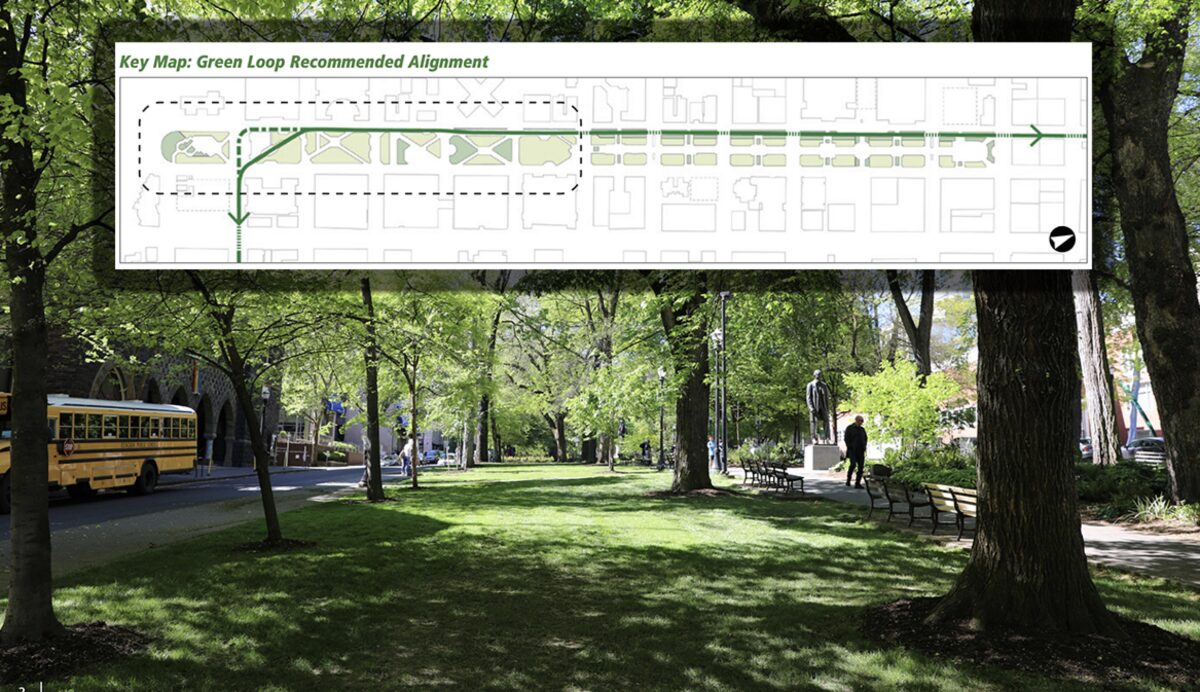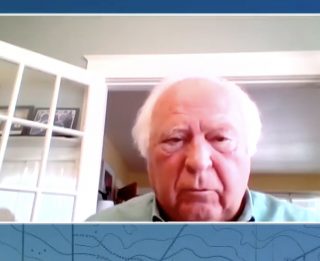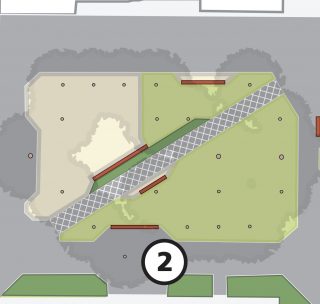
A plan to update the South Park Blocks and establish it as a key segment of the future Green Loop was roundly rejected by many downtown residents at a city council hearing Thursday. The opposition came after more than month of misleading and false statements circulating online about the suspected impacts of the plan and the alleged intentions of the Portland Parks & Recreation bureau.
The South Park Blocks Master Plan would impact 12 blocks of a linear park bounded by the Park Avenue couplet on the east and west and from SW Jackson near I-405 and Salmon Street to the north. The master plan is high-level, conceptual document that comes with zero dedicated funding and that includes zero completed projects or designs that are set-in-stone. Anything built from this plan would come before council and would have its own public outreach process. And according to Parks Commissioner Rubio and her staff the plan would not lead to removal of any existing trees.
Despite these facts, a vast majority of the nearly 60 people who testified Thursday urged council to vote no on the plan. Almost all of them said they’d lived on or nearby the South Park Blocks for many years. Their top concerns were that the plan would: result in more people using the park; mean less green space downtown; create a loss of what they see as their backyard and personal “oasis”; siphon money away from what they see as more important needs (even though the plan costs nothing); and that it would lead to a much busier corridor and become overrun with bike and scooter users whose disrespectful behavior would pose a threat to public safety.
At the outset of the meeting, Commissioner Rubio attempted to throw water on a fire she knew was about to start: “I know there has been some confusion and different opinions about this, so I want to be clear, passing the master plan does not mean trees are going to be cut down. Rather, the plan outlines a forward-looking tree succession strategy to guide replacing trees when they naturally reach the end of their lifespans.”
Advertisement

Rubio had to address the tree issue because of false claims of “mass tree deaths” spread by many people and groups online. Among them was former Portland City Council member Mike Lindberg. His May 31st Facebook post shows many large trees with yellow caution tape tied around them and a caption of, “In a nod to Portland history the South Parks [sic] Block Master Plan brings back Stump Town; the trees with yellow ribbons are destined for the wood pile.” The post went viral with over 200 shares and 340 comments. Unfortunately it’s extremely misleading. Not only is Lindberg wrong about his claim that the trees will be cut (they won’t be), but the tape was the work of an activist group — not the City of Portland.
The Green Loop, a conceptual idea that was formally adopted by council as part of the Central City 2035 Plan in 2018, also loomed large in the testimony. Also looking to set a tone before opposing voices could speak was Senior Parks Planner Tate White. In her presentation of the plan she pointed out that a new Green Loop path would only significantly impact one block of the 12-block park.
Many of those who spoke out against the plan think bicycle users are incompatible with the park because of the collision risks they’d create. They also oppose the diagonal path for this one block — which is ironic because Parks proposed this design specifically to improve safety. “We want to support it [Green Loop path] happening safely rather than pretend it will not happen, despite [this diagonal route] being an obvious desire line,” said White, during her presentation.
“If you do anything to disturb this urban sanctuary, the Downtown Neighborhood Association and the residents of downtown will not be happy.”
— Darlene Garrett
“The DNA represent a small cadre of their leadership who have quite honestly misled, lied, and intimidated others in order to try to get their NIMBY wishes accomplished.”
— Andrew VanDerZanden, citizen advisory committee member
Denyse McGriff, president of the board for the Architectural Heritage Center and an Oregon City commissioner, testified that, “These blocks are like pearls in a necklace, you can’t just take them apart and still have a necklace.” McGriff also opposed the plan on grounds that, “The Park Blocks are a place of contemplation and are devoid of visual clutter, so why do we need to add more stuff?”
This concern that the plan would make the Park Blocks too busy, and that “activation” of space is inherently a bad thing, was very prevalent among those against the plan. So too was the idea that most bicycle riders are reckless and their presence in the park would have terrible safety consequences.

One person testified that, “The South Park Blocks were never intended to support vehicle traffic like bicycles in the first place. Such a change would only increase the possibility of accidents for all the users of the park; but especially for older individuals or people with children or pets as they enter or leave the park, so why not find another more suitable alternative for bicyclists?”
Fears of more bicycle riders in the park has animated members of the Downtown Neighborhood Association for years now. The DNA is now leading the fight against the plan and likely helped turn out many of the opposing voices on Thursday.
Andrew VanDerZanden was on the plan’s citizen advisory committee and said in his testimony that the DNA has not acted in good faith since the start of the public process. He spoke of CAC meetings with, “Numerous and constant attempts by the DNA’s representative who dominated conversation, prevented other participants from having their voices heard, and actually breaking rules of decorum.” VanDerZanden said within a few meetings he realized the DNA wasn’t interested in productive dialogue and “That they had come in with an agenda from the outset and they were going to do whatever it took to prevent any changes from being made to the South Park Blocks.”
“The DNA does not represent the whole community,” VanDerZanden told city council, “They represent a small cadre of their leadership who have quite honestly misled, lied, and intimidated others in order to try to get their NIMBY wishes accomplished.”
Advertisement
A woman who lives in the South Waterfront District was concerned that the plan, “Changes the fundamental character of the Park Blocks from an urban oasis of serenity and beauty to a busy hub of activity and transit.”
“It’s bad enough with pedestrians playing cat-and-mouse with two to three lanes of incoming traffic,” said another person, who described himself as an “avid cyclist”. “With cyclists who are notoriously averse to yielding to traffic or pedestrians — myself included — This will make a very dangerous series of crossings.”
One of the lead organizers of opposition to the plan, the former newspaper reporter Fred Leeson who wrote the misleading “Assault on the South Park Blocks” blog post said, “The bicycle lobby has little interest in the park, other than creating in invasive bicycle route.”
Local resident (nearly every person in opposition stated that they live on or very nearby the park) Robert Wright said that, “Any modifications should be calming, not activating… bicycles, skateboards, e-scooters and electric bicycles will certainly not be calming for pedestrians and those with mobility issues,” she said. “A stroll on the Waterfront Park Trail and the Eastbank Esplanade is a look into this future.”
Resident Darlene Garrett voiced fear that the Park Blocks would attract fast bike riders: “I use the park blocks every day, and I rarely see children or families riding bikes in or around the park. Most of the bike riders that I see living downtown are serious bike riders, they’re commuters. I absolutely believe that there should be a commuter route, and that should not be the park blocks.” (Garrett must not have heard Parks staffer Tate White explain at the outset of the meeting that protected bike lanes already exist and/or are being built on nearby SW Broadway and Fourth Avenue “for faster moving cyclists.”)
“If you do anything to disturb this urban sanctuary,” Garrett warned. “The Downtown Neighborhood Association and the residents of downtown will not be happy.”
Veteran active transportation activist Doug Klotz responded to Garrett’s testimony. “She said that she didn’t see any families and children riding here, and that’s exactly what the Green Loop will provide,” Klotz said. “It provides a space for slow-speed biking, protected space where you won’t be hit by cars. And people who want to ride their bikes faster, they’ll probably use the other routes… Nobody wants to be dodging children going slowly, and most cyclists have a sense of responsibility.”
But Klotz was a lone voice of support for the idea that people can ride bicycles responsibly.
Sue Dell said, “I don’t think it makes it at all possible to mix bicycles and pedestrians. If you look at the East Side Esplanade… I’ve actually seen children hit by bicycles on the waterfront.”
“The parks blocks are very Eurocentric, the narrative is very Eurocentric, very linear… They are for the carriages of the queens and kings to bring their people through.”
— Judy BlueHourse Skelton, Nez Perce/Cherokee tribal member
And Janet Van Wess simply could not fathom a Green Loop path that would be pleasant for everyone. “One of the renderings shows what I assume is a mom walking with her preschool-aged children on the Green Loop perhaps teaching them how to ride a bike,” Van Wess said dismissively. “This would never be able to happen on the real Green Loop, especially as the downtown loop will be treated as a highway for cyclists, scooters and one-wheelers, not as a wheeled tootle through the park.”
One of the people who spoke against the plan is the descendent of one of Portland’s earliest leaders, Josiah Failing. Failing was Portland’s fourth mayor in the 1850s and his great, great grandson Bill Failing said he showed up to represent history. “We have deep family roots here,” Failing said, “I want us to ask ourselves this important question: Does history matter?”
Thomas Wray said, “The South Park Blocks have been my family park for 6 generations”.
But Nez Perce/Cherokee tribal member, Portland State University Indigenous Nations Studies Professor, and South Park Blocks Plan Community Advisory Committee member Judy BlueHorse Skelton said there’s a deeper historical context to consider when we think about the past and future of the park blocks.
“We can’t look at the pictures [of the park] without wondering, where are the indigenous people?” Skelton shared in her testimony. “The park was created at a time when over half of the nation’s population was not participating, were not there, were not at the table. The parks blocks are very Eurocentric, the narrative is very Eurocentric, very linear… They are for the carriage of the queens and kings to bring their people through.”
After Skelton’s words, it was quite jarring to hear the leader of the opposition, Mike Lindberg, say a few hours later, “We don’t think that we really need more scooters and electric bikes to honor the indigenous population.”
While opposition dominated the meeting, there were several notable exceptions. Portland architect and founder of the Next Portland blog Iain MacKenzie used to work at a cafe on the South Park Blocks in the early 2000s. “If there was a plan to harm the park blocks, I’d be here in opposition,” he said, before expressing dismay at the dishonest campaign around tree removal.
Cathy Tuttle, a former parks planner for the City of Seattle said she moved to downtown Portland recently specifically because it allows her to grow old gracefully. “I don’t want to live in a city that forces me to drive to meet my daily needs. My e-bike, keeps me independently mobile… I love the idea of a people-first, Portland Green Loop downtown. This plan is a start.”
Council will likely vote on the plan this coming Wednesday July 21st at their 9:30 am meeting. See the agenda item here.
— Jonathan Maus: (503) 706-8804, @jonathan_maus on Twitter and jonathan@bikeportland.org
— Get our headlines delivered to your inbox.
— Support this independent community media outlet with a one-time contribution or monthly subscription.


